American Sabbatical 106: 5/5/97
St. Louis
5/5.. St. Louis
After visiting the smoke-filled room, we whooshed across the hydraulic threshold and out into a light
Spring rain. Time to make tracks for St. Louis, Louis. Peggy chose
the river road along the north bank, and it was a goodun. Limestone
bluffs outcropping behind the flowering hardwoods and pastel greens.
We’ve seen so many 19th century sketches of Missouri bluffs that
driving beside the real thing is playfully anachronistic. And
all the Missouri license plates puts me in fugue. Everywhere we’ve
gone in America we’ve seen MO plates. They say “SHOW ME” , but
they might say “I’LL GO SEE MYSELF.” I’d expected Californians
to be ubiquitous, but Missourians are the great travelers. Another
case of ontogeny recapitulating phylogeny. Live at the historic
gateway, you gotta go. Now seeing show me plates on every car
is like being everywhere at once. Am I still making sense?
We’re back in Huck and Tom landscapes. Maybe that’s why it seems
so familiar. Land of our native myth. Occasionally the road dips
into dank lowland, beside serpentine creeks with the trees waist-deep
along the edges. Then zigzags up to a vantage over the wide Missouri.
The abandoned railroad line along this shore has been transformed
into and bike and hiking path, the Katy Trail, and taverns and
craft shops and B&Bs have sprung up to serve the new travelers.
A fine way to cross Missouri. There’s hardly any traffic, and
we amble along at absorption speed, soaking up these rich intervales.
Corn sprouting on the alluvial flats, houses perched on the natural
levees just below the bluffs, raptors gyring in the lip updrafts.
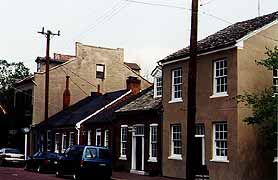
St. Charles, MO
|
We make an upland detour at Defiance to inspect the last of the
Boonies. Daniel Boone’s final homestead. After his real estate
speculation had once again bankrupted him in Kentucky, and his
political name was mud, he moved off beyond the sound of his neighbors’
axes, crossed the great water and set up housekeeping here, in
the 1790s. Took a Spanish land grant and began again with a grandchild
or two. Early 19th century traveling journalists would make the
sidetrip at Defiance to do homage to the old veteran. Could we
do less? |
| We did as little as possible. Peggy began to moan softly as we
pulled into the parkinglot at the Boone site. It was full of school
buses, and you could see yet another reconstructed frontier village
being assembled in the background. “Do I have to?” was her plaint.
“Naw. I just wanted to see the shape of the hills,” I said as
we wheeled out. It’s still idyllic country for a small farmer.
Just beyond the reach of outer St. Louis. |
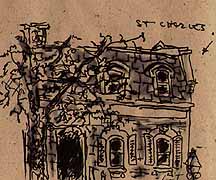
St. Chas
|
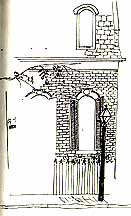
Peggy's take
|
We were in for it, however. Ridge riding and plunging over the
last convolutions above the American Bottom, then down into thundering
malldom. The Owl navigator kept us along the riverbank as the
Missouri makes its last wide S-curve northward to the confluence.
We were hunting for the old town of St. Charles, where we might
find traces of Creole heritage, and a good meal. Both, in fact..
in a scrubbed brick oldtown full of antique shoppes and tourist
gawkoriums. The sun came out just in time for us to enjoy spinach
quiche and iced tea under blossoming trees, among all the brick
and wrought iron. The proportions of early 19th century buildings
out here in the howling wilderness have the same human graces
as their colonial counterparts in New England. Isn’t it curious
how builders have tried to mimic the look ever since, and failed
so miserably in finding the just proportion? |
| I perused the waterfront while Peggy cruised the stores. All these
floodwater towns now give the river plenty of berth, and the ultimate
edge is usually a morass of mudcoated wrack. Time and again I’ve
approached the banks of these heartland rivers only to find the
last 10-20 yards too soupy for indulgence. There’s no big levee
to block the view here in St. Charles, which must make it deep
in floodtime, but there’s no pierhead either, and I watch the
brown turbulence through the usual thicket. Headed back to the
old streets I encounter a couple of old cranks building a replica
riverboat. A 30-foot bateau, to be sheathed in glass. One of them
spent a decade constructing a keelboat like the one Lewis and
Clark set out from here in. One year he and a party took it on
a repeat voyage, following the explorers’ journals, going day
by day upriver. The other builder had canoed down the Big Muddy
all the way from the falls to here. Now they were reconstructing
the smallest boat that Lewis and Clark used, for some further
adventure. We talked hulls until the whistle blew. This baby was
a flat-bottomed, round-bilged double-ender. Kind of how I feel
after 26 thousand miles. |

While she shops..
|
Then it was time to find Schandorff. Peter and I went to high
school together and had been together in the two most memorable
classes I’d ever had. US History with Fritz Allis, and English
with Dudley Fitts. I remembered him as witty and articulate and
another misfit in that classy environment. He’d gone to college
with Peggy, but they’d never crossed paths there. Unlike all the
rest of my classmates, whom she dated.. usually in preference
to me.
Peter’s directions took us into a posh suburb where a goodly portion
of St. Louis’ cashflow piles up, to judge by the manses. He’s
an instructor (US History, of course.. also Oriental Studies and
Debate) at a private school in this enclave, and as much an institution
here as Fritz and Fitts were at PA. And still a live wire. He
took us on a tour of the school, nosing into weightrooms and clay
studios, telling us how the library had been endowed by default,
when a communard heir refused a grotesque inheritance.
Peter, it turns out, has been an Equity actor for decades and
a tour with him is full of dramatic turns. Rotund and bespeckled,
he could play a fussy Dickensian academic, and probably does at
need, or be a rowdy Falstaff among friends. A wonderful companion.
Having decided we weren’t hopelessly dull, Peter invited us to
spend the night at his house, and led us on a merry chase across
the city in his black Camaro.
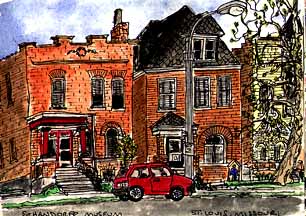
Schandorff Museum
Peter lives in an 1890’s brick townhouse in a shabby gentile St.
Louis neighborhood, directly across the street from St. Margaret
of Scotland. Totally integrated, utterly unpretentious, completely
comfortable. As always, we worried about the Owl on city streets,
and Peter assured us there would be nobody ruffling the bird’s
feathers. The church runs things here, he assured us. “Nobody
crosses the nuns.” Before they “cleaned up” city hall, your surest
recourse for a traffic summons was to drop it and a five dollar
bill into the collection plate. Peter didn’t even roll up the
window of his Camaro for the night. A civil city? Unbelievable.
Excellent Thai food down the street, and a tour of the Schandorff
Museum highlighted our stay. Peter is a world-traveler and a compulsive
hoarder who has indexed archives of his life experiences. It’s
a fabulous trip to follow him through Tibet and up the Yangtze
while admiring his collections of Orientalia. The guest bathroom,
for example, is a shrine to Chairman Mao, while the spare kitchen
is a gallery of swimsuit calendars, all exposing Miss May this
month. He showed us a Chinese Penthouse Magazine emblazoned in
characters and the English boldface: HOT STUFF. He challenged
us to discriminate between an authentic Chinese antiquity and
a pot from Pier One. We guessed wrong.
We could tell Peter delights in wry. He offered us frozen gin..
and Diet Pepsi. The weary Owlers must have seemed tongue-tied
and stupid to him, and he kindly put us to bed before the witching
hour. We are getting punchy, folks. This last week may be a long
one. But if it has energizing encounters like this one we should
get home before we collapse.
5/6.. New Harmony.
Birdsong and the neighbors going to mass met us in the AM in St. Louis. I sat on the sunny
steps of St. Margaret’s and sketched, sipping Chinese tea. The
parishioners smiled and wished me good day. This is the way city
life might be. Civil, cordial, and safe. Hats off to St. Louis.
Each place we visit is colored by the people we see there, of
course. St. Louis seems very cosmopolitan and welcoming, in large
measure thanks to Peter. But Missouri had already turned my head,
and I’d wondered why St. Louis had been a blank spot in my geography.
Dark, if not dangerous. Missouri has a bloody history, to be sure.
The contentious territory of the slave debate and the scene of
so much border bloodletting. Quantrill and Jesse James are folk
heroes here. Somehow I think of knives when I think Missouri.
Or I did.

The Arch
|
Now I feel this is the heart of the continent. Where the waters
come together, and all the streams of the culture merge. East
and West. North and South. Black and White. The darkest, souldead
places we’ve seen on this trek have been on the alluvial flats
of the Mississippi confluences. But the most enticing historic
mysteries have been there, too. The Mississippian mounds. Memphis
scared us. But New Orleans, and now St. Louis, have filled my
head with an emotional longing.. Jazz and drawling voices, like
Kate Chopin and Tennessee Williams. Maybe this is the sacred heart
of America, with a slight French accent.
|
We cruised the sidestreets through unpretentious neighborhoods
that looked alive and well, until we struck on downtown, dominated
by that incredible arch. Even the new skyscraper abuilding in
its frame can’t mar the sculptural effect. The business district
seems unhurried and uncrowded, but not moribund. The steamboat
casinos at the levee were already.. or still.. open for indulgence.
| At the foot of the arch is an earlier gateway to the West. The
Eads Bridge. The first crossing of the Mother River in full flood.
Petroski starts his history of the great bridge builders with
Eads, and this is still one of our great engineering feats. A
triple-arched span of steel trusswork on stone piers with the
roadway on top, you can feel the rushing waters humming through
this instrument. The big story of this bridge is all under water,
where Eads utilized his waterman’s expertise to root this thing
so deep even the Mississippi couldn’t rip it up. It’s building
is a great yarn, and it’s a charge to stand with the glittering
arch above you and that 19 century ironwork spanning the river
before you. |
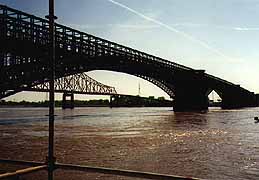
Eads Bridge
|
We crossed on the mundane interstate bridge and made haste across
Illinois. The last time through we spent more than a week here,
and we’re determined not to get waylaid this time. It’s a straight
shot from St. Louis to the southern tip of Indiana, and we make
it in 3 hours, even taking secondaries most of the way. It’s not
so devastatingly flat down here as in Central Illinois, more tree
lines. Even the intensity of factory farming seems less oppressive
here, especially as you go east, but we didn’t dawdle to absorb
the ambiance. I was dozing on the sunny side of Owl when Peggy
said, “Bryce. It’s the Wabash,” and we were among Hoosiers.
We were vectored for New Harmony, one of the intentional communities
Peggy has on her list of memorable sites, and the way is by back
alley from our river crossing. These alleys are some twitchy,
too. The narrow twolane makes ninety degree turns every quarter
mile or so, and the feeling is very British. My English uncle
used to explain the tortuous meanderings of English lanes by saying
they’d been traced by sturdy yeomen staggering home from the pub.
In Indiana the twitches are probably the perimeters of quarter
sections, the gridding of America. The topology is more rumpled
here than across the Wabash, and the settlement pattern decidedly
different. The houses sit on hillocks, with rolling farmland between.
I remember that much of Southern Illinois, Indiana, and Ohio,
were drowned forests when the first settlers came here. A scattering
of upland prairie, but mostly a dank and gloomy swamp. When George
Rogers Clark marched through here during the French and Indian
Wars the accounts recorded endless slogging through forested mire.
The trees held the moisture. Once cleared and ditched, the land
drained and proved to be fabulously rich. The hilltop housing
is a reminder that the essence of this land is reclaimed swamp.
The curves hold our speed down. Local traffic is sparse. And the
Spring effusions are charming all the way to New Harmony.
(Memo #104)
May 6 New Harmony communes
Who? followers of George Rapp and Robert Owen, educators, scientists
What? religious commune, then utopian community
When? 1814 to Civil War
Where? southwest Indiana on Wabash River
How? practical religious sect, impractical social reformers
Topics: communes, utopias
Questions: Why were a religious commune and a utopian community
organized at New Harmony? Why didn’t they survive? What were their
successes and failures? |
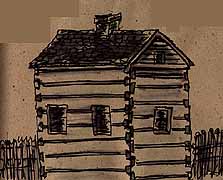
Cabin At New Harmony
|
Paul Tillich, George Rapp, Robert Owen, Prince Maximiliam, Karl
Bodmer and Frances Wright (a theologian, a charismatic sect leader,
a visionary social reformer, an explorer, an artist, a feminist-abolitionist)
are all part of the odd history of New Harmony, Indiana. New Harmony
is in the southwest corner of Indiana, a rolling green country.
It sits on the Wabash River which is a wide placid waterway at
this point, ideal for boat travel. From 1826 to the Civil War
New Harmony was a scientific and cultural Mecca attracting scores
of distinguished American and European visitors with its lectures,
laboratories, and schools.

New Harmony by Bodmer
Today New Harmony is a small quiet village quite off the beaten
track. The village center shows recent renovation with a few galleries
and restaurants and antique shops. The historic buildings lie
along quiet tree shaded streets scattered among modern houses.
There is a quite amazing center for tourists called the Athenaeum,
a huge stark white building designed by Richard Meier. It contains
a gift shop, an exhibit on the two intentional communities that
existed at New Harmony, and a theater where I watched the film
on New Harmony. The building overshadows the artifacts. In fact
the whole tourist enterprise is oddly disjointed. It is almost
as though there are so many stories to tell (you have six tour
options with at least three buildings in each !!) that they can’t
decide on a focus and so everything is fuzzy! There are frontier
cabins, Rappite and Harmonist houses, Victorian houses, town structures,
empty sites (“This is where the rope walk was”), a labyrinth (which
symbolized the difficult path to perfection for the Rappites).
Some buildings have been moved, some renovated, some totally reconstructed.
Some important commune sites are now in private hands to be glimpsed
through garden gates. Memorials and an open air church have been
constructed. The village is a melange of historical sites and
quite weird.
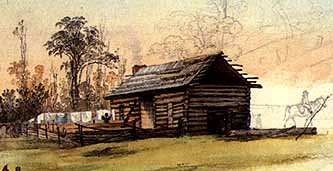
Settler's Homestead by Bodmer
|
A few farmers were cultivating the rich Indiana loam when George
Rapp reconnoitered the area and bought 30,000 acres as a commune
site. He was a Lutheran sect leader who had brought 700 followers
to this country in 1804. His first commune was in Pennsylvania.
The Rappites believed that the Second Coming was imminent. They
owned property in common and were virtually self-sufficient. They
also started a number of small businesses to support themselves.
They were quite successful especially in the production of textiles. |
| Rapp established his new center at “Harmonie” in 1814, a planned
town for a religious commune. The group quickly built cabins and
then more substantial houses for sect members. All followed the
same floor plan which enabled them to prefab the houses with wood
from their own mill and bricks from their own kiln. Once you’ve
seen the Rappite style houses, they are easy to spot: two rooms
and an entry downstairs, two rooms up, a steep roof pitch. They
had their own form of insulation. I toured the Lenz house which
has been furnished with furniture “of the period”. The Fauntleroy
house is an example of a Rappite house that went through several
expansions and was inhabited into the twentieth century. It has
furnishings from several periods. |
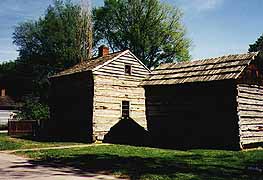
Log House
|
The Rappites built 150 structures in the town including community
houses (or dormitories) where young males moved at fourteen. Rappites
lived in family groups, but there was voluntary celibacy. A huge
brick church was constructed. By 1824 they were marketing twenty
products to stores from Pittsburgh to New Orleans and abroad.
Rapp decided to move his group back to the first site in Pennsylvania
(nearer markets?) and he sold the town and its small businesses
to industrialist Robert Owen.

Economy - Rapp's Commune on the Ohio
(Bodmer)
Owen was a Welshman who became the owner of an early textile mill
at New Lanark, Scotland, where he instituted a number of social
reforms intended to improve life for the workers - day care, schools,
lectures, improved housing, free medical care. Owen believed that
environment formed character. Science and education could create
social equality and he believed in the equality of women. He saw
the United States as offering the most supportive site for his
social experiments. He teamed financially with the famous American
geologist William McClure to create a utopian community.
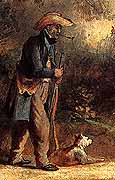
Lesueur
(Bodmer)
|
They bought Rapp’s commune / town and renamed it New Harmony.
Then Owen set out to attract followers. Owen’s own children immigrated.
He toured and lectured inviting people to come and take part in
his social experiment. And they did. Reformers, scientists, educators,
feminists, abolitionists flocked to New Harmony, the first group
coming up the Wabash in a “boatload of knowledge”. The luminaries
included McClure, Charles Lesueur, Thomas Say, Marie Duclos Fretageot,
Frances Wright. New Harmony sprouted schools and laboratories
and lecture halls, a theater group (which has continued into the
present), an opera, a newspaper, Indiana’s first public library.
An idealistic Constitution was written, but the commune members
soon requested that an Owens lead them. The Rapp church was used
as a town hall for dances and lectures. Pestalozzi principles
of education were used which involved the students in research,
hands-on experiments, and vocational activities. Owen also stressed
art and music. |
|
The New Harmony community only lasted two years. Few of the new
arrivals wanted to run the many small businesses Rapp had left.
Science flourished, not business. There were conflicting philosophies,
for education in particular. Factions sprang up. New Harmony was
largely supported from 1824-26 by Owen’s personal fortune. He
bailed out in 1826. A number of communes sprang up in the US from
New Harmony's seeds, but none is mentioned as successful. |
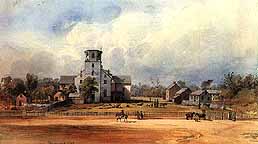
New Harmony by Bodmer
|
Some people - including Owen’s children - stayed on in the community
and it remained an educational and scientific center until the
Civil War, a community not a commune. Those who stayed supported
themselves as best they could.

Rappite House
|
I toured the Athenaeum, a cabin “like the first ones the Rappites
built”, a later Rappite house, a house with many additions, the
site of the Rapp rope walk, the open air chapel (dedicated in
about 1960), a garden memorial to a descendant of Robert Owen.
And walked around the sleepy Indiana town. It felt like a jumble
of historic facts and sites. Too much to really take in or to
organize well in a memo, I’m afraid.
|
| For two minutes after I entered the Athenaeum I thought I would
have the ultimate treat ! A sign announced that New Harmony has
a “definitive collection of Bodmers”. It turns out that Bodmer
and Prince Maximilian had stayed in the community for most of
the winter on their way west! We had just gone to see the Bodmers
in Omaha and loved them! What an opportunity I thought. But.....the
works at New Harmony were being restored and couldn’t be viewed!
“Can you come back in a few months?” I was asked. AAARRRRRH |
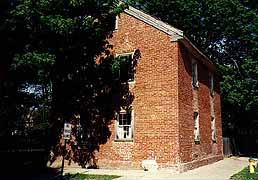
Brick House
|
5/6.. cont.
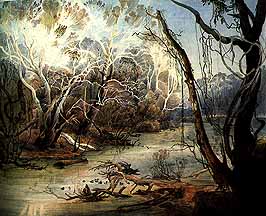
View of Wabash by Bodmer
New Harmony is right on the banks of the Wabash, here a yellow-brown gentle-flowing
river of respectable width. A high truss and girder toll bridge
reaches back over to Illinois. While our historiographer took
the tour, I went and sat in the roofless church by Philip Johnson.
A walled enclosure with a 40 foot high shingled, morel-shaped,
canopy over the high altar. A most peculiar space. More so because
grounds crews were mowing the floor, and around the walls. Eventually
I went back to Owl’s lot and fell asleep under a shade tree.
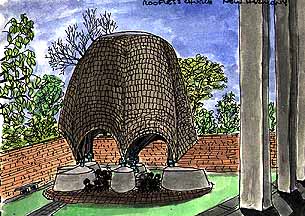
Philip Johnson Church
Peggy came back groggy with compounded data from the interleaved
history of this place, and from tourissima terminatus. “Take me
to Vincennes,” she begged, and we zigzagged up the Wabash to another
outpost of the East Indian Motel Culture.. with a heated indoor
pool! Aaah.

















